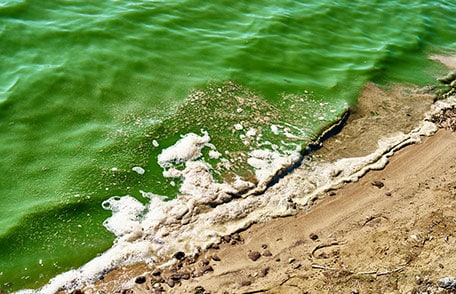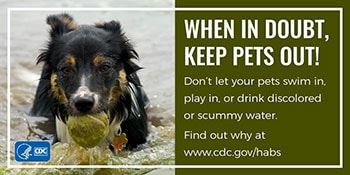Avoid Harmful Algal Blooms

Harmful algal blooms can produce toxins (poisons) that can make people and animals sick and affect the environment. Learn more about them to keep you and your pets safe.
During warm weather, tiny plant-like organisms—algae and cyanobacteria—are more likely to grow out of control in rivers, lakes, and oceans. These overgrowths—or “blooms”—sometimes look like foam, scum, mats, or paint on the surface and can look or smell bad. They can even make the water appear different colors, including green, red, brown, or blue. Some of these blooms are called harmful algal blooms because they contain toxins or become very dense. Harmful algal blooms can make people and animals sick or be harmful to the environment.
Blooms are becoming more frequent as temperatures warm and the amount of nutrients in our waters increase. Levels of nutrients increase when fertilizer, sewage, and runoff from cities and industrial buildings get into the water.
How People Get Sick
You can’t tell if a bloom is harmful just by looking at it, and you can’t easily see all blooms.
People or pets can get sick when they have contact with harmful algal blooms in these ways:
- Swimming, kayaking, fishing, wading, or doing similar activities in contaminated water.
- Breathing in tiny water droplets, mist, or wind-blown sea spray that contains toxins.
- Drinking contaminated water.
- Eating contaminated seafood (fish or shellfish).
Illnesses and symptoms from harmful algal blooms can vary depending on how people and animals are exposed, how long the exposures last, and the type of toxins involved.
Symptoms can include:
- Skin, eye, nose or throat irritation
- Stomach pain
- Headache
- Neurological symptoms such as muscle twitches
- Vomiting
- Diarrhea
Exposure to some harmful algal blooms can also harm your liver and kidney. If you think you or your pet have become sick because of a harmful algal bloom, see your healthcare provider or veterinarian. Animals can get very sick quickly, so don’t delay contacting your veterinarian.
Reporting an Illness
Report any illness associated with a harmful algal bloom to your local, state, or territorial health department. In some states and territories, this can be done through an online form or a hotline.
If you have immediate questions about your symptoms, call your local or state poison center at 1-800-222-1222.
When in Doubt, Stay Out
When visiting lakes, rivers, or oceans, check your local water conditions. Follow any advice your state or local environmental health department posts online or near the water.
If a health notice is posted or if you suspect a harmful algal bloom may be in the water, follow these recommendations:
- Don’t swim or come in direct contact with water that smells bad, looks discolored, or has scum on the surface.
- Don’t let pets drink, play, or swim in water or eat algae.
- Stay out of the water if it has dead fish or other dead animals in or near it.
- Know the health risks of eating contaminated fish and shellfish and follow warnings.
Follow guidance from your local health officials if you learn about a harmful algal bloom in your area or if you are notified that your tap water contains algal toxins.

Animals are often the first affected because they are more likely to swim in or drink from bodies of water that contain algal blooms.
How CDC Collects Data to Protect Health

Because harmful algal blooms affect people, animals, and the environment, it’s important to track when they happen, where they happen, and whether they cause illness. CDC’s One Health Harmful Algal Bloom System (OHHABS) is a web-based national tracking system for harmful algal blooms. Health departments and their designated environmental health or animal health partners can use this voluntary system to report harmful algal bloom events and associated illnesses in people and animals. The data collected help CDC and its partners learn more about these blooms and understand how to best prevent them and the illnesses they cause.
Harmful algal blooms are an example of a One Health issue. One Health works to solve problems based on the idea that the health of people, animals, and the environment are connected. Using this approach to track harmful blooms means that human health, animal health, and environmental health experts work together to understand and more effectively address the problems that harmful algal blooms can cause. Learn more about harmful algal blooms and One Health in action from a story about poisoned sea otters in California.
More Information
- Harmful Algal Boom FAQs
- Health Promotion Materials
- EPA—Cyanobacterial Harmful Algal Blooms (CyanoHABs) in Water Bodies
- U.S. Geological Survey—The Science of Harmful Algal Blooms
- National Oceanic and Atmospheric Administration—Harmful Algal Blooms
- National Park Service—One Health and Disease: Harmful Algal Blooms
- U.S. Climate Resilience Toolkit—Alaskan Tribes Join Together to Assess Harmful Algal Blooms






















.png)











No hay comentarios:
Publicar un comentario